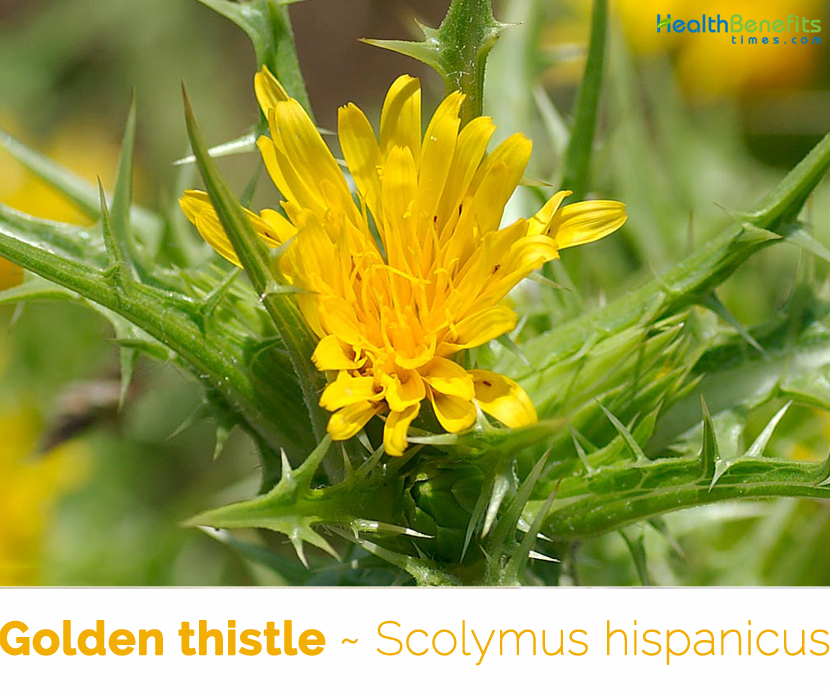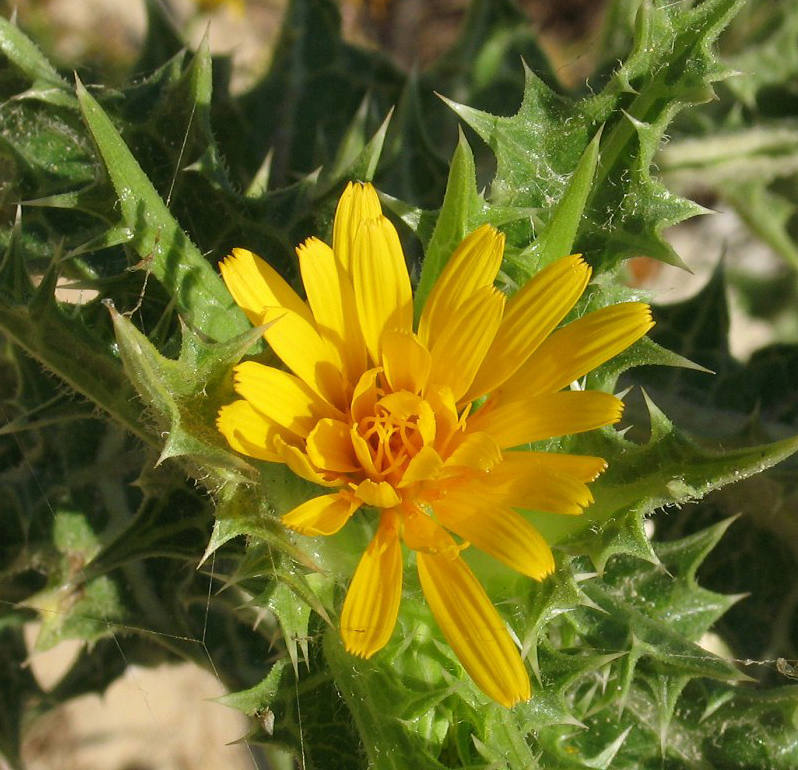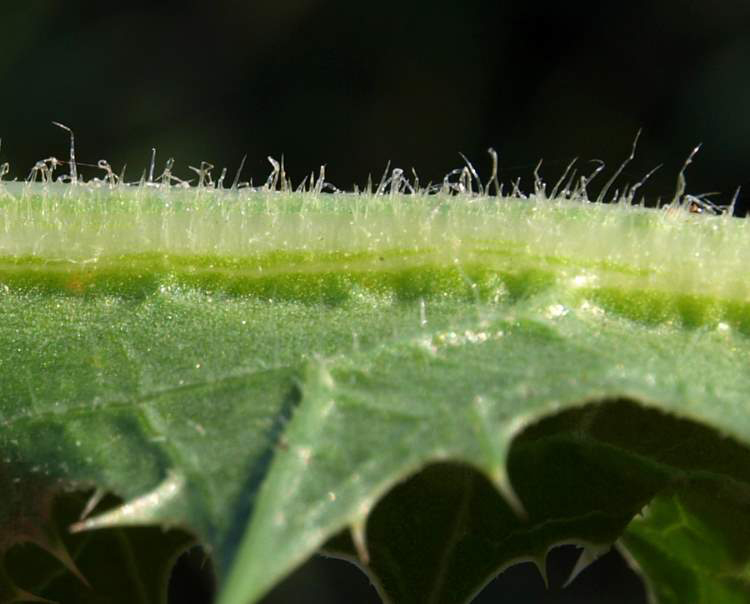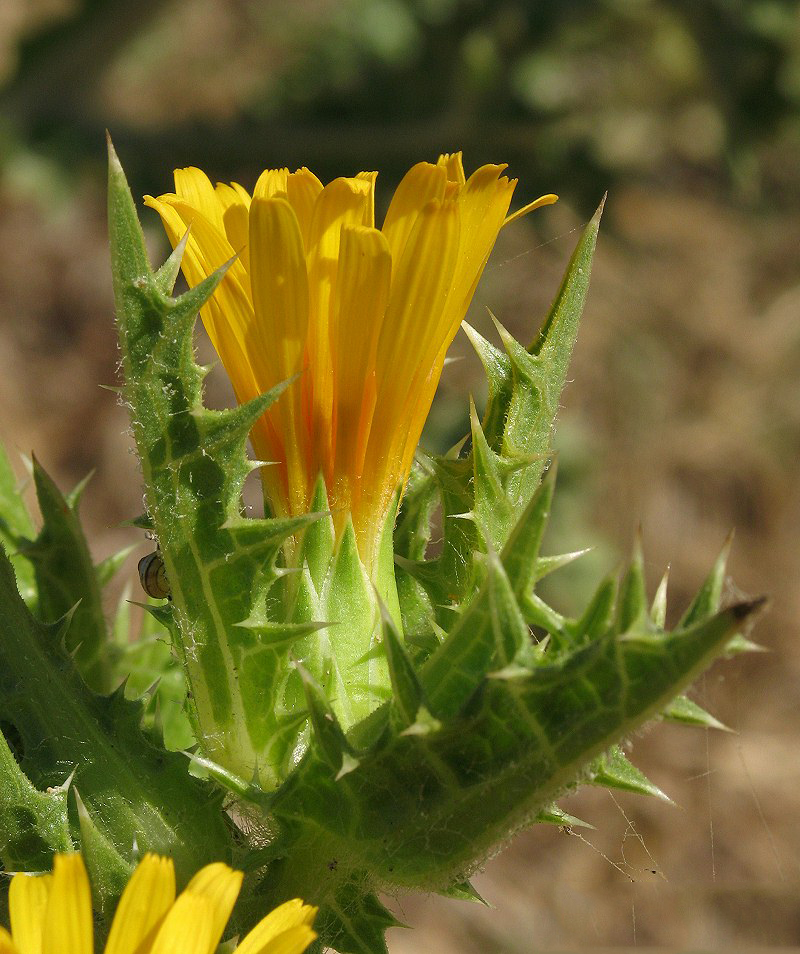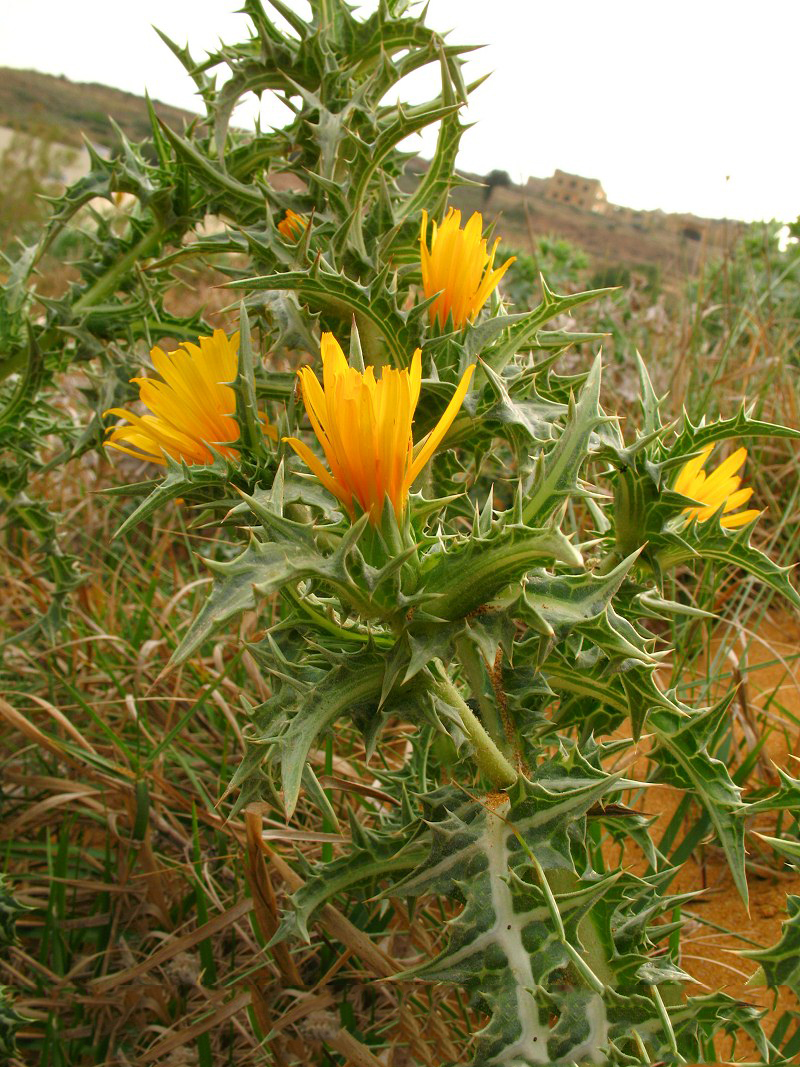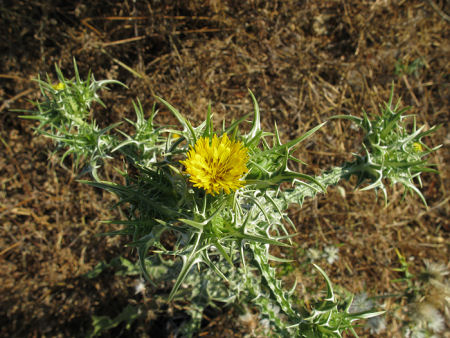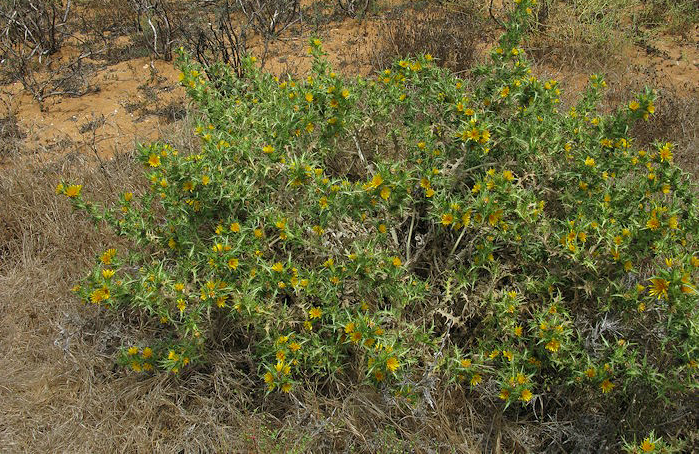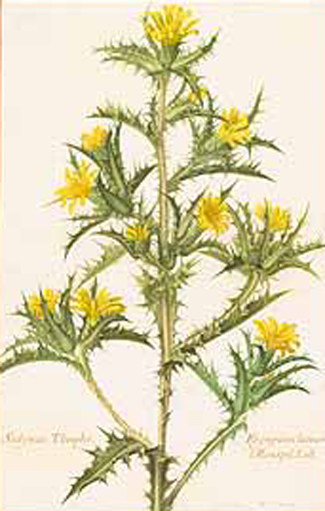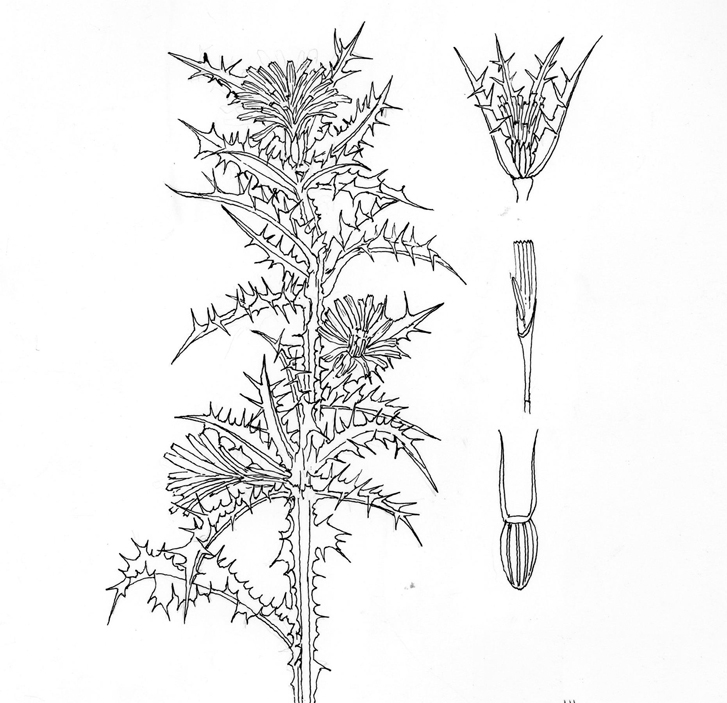| Golden thistle Quick Facts |
| Name: |
Golden thistle |
| Scientific Name: |
Scolymus hispanicus |
| Origin |
Southern and western Europe, north to northwestern France |
| Colors |
Yellowish-brown |
| Shapes |
Achenes club-shaped, flattened 2–3 mm long, with a pappus of hairs forming a short corona |
| Calories |
38 Kcal./cup |
| Major nutrients |
Vitamin K (31.67%)
Iron (29.50%)
Vitamin B9 (25.75%)
Calcium (23.50%)
Magnesium (22.36%)
|
Scolymus hispanicus, the common golden thistle or Spanish oyster thistle, is a flowering plant in the genus Scolymus in the family Asteraceae. It is an herbaceous biennial or short-lived perennial plant native to southern and western Europe, north to northwestern France. It has a circum-Mediterranean distribution, extending also to northwestern France and the Canary Islands. Few of the popular common names of the plants are cardillo, Golden Thistle, Spanish Salsify, Spanish Oyster-plant, Spanish oysterplant, Common goldenthistle and sunnariah.
Plant description
Golden thistle is an erect, prickly herbaceous, biennial or short-lived perennial herb that grows about 80 cm tall. The plant is found growing in uncultivated agricultural fields, roadsides, waste places, nitrified lands, on almost all types of soils, disturbed sites, fields and grassy areas. The plants occur in dry sites and soil ranging from poor gravels to fertile alluvial loam. Stem is erect, sometimes single but usually several stems are produced from a crown. Stems have many branches, are spiny winged and covered with fine down, containing milky sap.
Leaves
Golden thistle leaves have a multi-colored appearance due to light-colored veins and markings and contain milky sap. Lower cauline leaves are narrowly oblong, 12 -20 cm long, 2.5-4 cm wide, pinnatifid, spinose to denticulate, glabrescent or pilose; lateral lobes are broadly deltoid. Middle and upper cauline leaves are spinose and amplexicaul. Leaf bases extend down the stem as spiny wings with upper leaves reflexed.
Flowers and fruits
Golden-yellow florets occur on solitary flower heads of 2.5-4 cm in diameter. They develop on very short stalks in the leaf axils with each head surrounded by a few very stout, spiny bracts. Flowering normally takes place from May, June, July and August. Fertile flowers are followed by club shaped achenes, flattened 2–3 mm long, with a pappus of hairs forming a short corona. Fruits are initially green turning to yellowish-brown as they mature. Seed is yellow-brown, flat with a membranous margin or wing. Including the wing, they are about 7 mm long and 5 mm wide. The seed itself is about 5 mm long and 2 mm wide.
History
The oldest known references are those of Theophrastus (371–287 BC) and Pliny the Elder (23–79 AD). Theophrastus told us that its root is eaten both raw and cooked, being juicier when the plant is flowering (Teofrasto 1988). Pliny the Elder mentioned that it is eaten in the East and used by the poor, and finally that it is said to possess diuretic properties in a very high degree (Bostock and Riley 1855). Clusius (1576) mentioned the edible use of the young plants with their root, either raw or in meat stews in the Spanish province of Salamanca.
Traditional uses and benefits of Golden thistle
- Infusion or decoction of the flowers are used to treat diarrhea and other digestive problems, it has been widespread in Spain, both for humans or animals.
- The use of this plant against fever has been stated in Italy and Spain, where a decoction of the flowering plant was used against malt fever.
Culinary Uses
- The stalks can be eaten raw or boiled.
- Different parts of this plant have been traditionally consumed, particularly the midribs of the tender basal leaves and the outer part of the root.
- Whitish and fleshy midribs are eaten either raw as a snack, raw in salads, or much more frequently cooked, in most of the Mediterranean countries, such as Portugal, Spain, Italy, Greece, Cyprus, Tunisia and Morocco.
- It is one of the most valued wild vegetable in many of these countries, being even considered as a part of the Mediterranean culinary heritage.
- Midribs are washed, sliced, and usually boiled in water with salt, being next prepared in different ways, such as sautéed with garlic and ham, fried in batter, with scrambled eggs or in omelets, for stuffing pies like the South-Italian verdhët, etc.
- They have been also commonly used as a vegetable garnish for other dishes, like the Spanish cocido or the North.
- The consumption of the root, mentioned by Theophrastus in third century BC, is very rare nowadays in Spain, with only two recent ethno-botanical references.
- Traditional use of the flowers as a saffron substitute, documented by Clusius in the sixteenth century in Spain, only has been recently registered in the province of Madrid, though completely abandoned.
- Flowers were also used as preservative, to curdle milk for making cheese or curd in several parts of Spain and Italy.
- Besides curdling the milk, the dry flowers give the cheese a characteristic yellowish color.
- Roasted root is a coffee substitute.
- Young leaves and leafstalks are blanched and used in salads.
- Flowers are used to adulterate saffron (Crocus sativus) as a food coloring.
Recipe
Golden Thistle and Lamb Stew
Ingredients
- 1 kg of golden thistle
- 400 g of lamb meat (cubed)
- 1 onion, chopped
- 2 garlic cloves, chopped
- 3-4 tbsp of olive oil
- Water
- Salt (to taste)
- 1 tbsp of flour
- Juice of 1 lemon
For the sauce:
- Juice of 1 lemon
- 1 tbsp of flour
Direction
- Put the water, flour and lemon juice in a deep bowl. Strip the leaves of their thorns, peel the roots and remove their central woody portion.
- Chop the cleaned golden thistle into 4-5 cm pieces and place in this water. (You can also use pre-cleaned golden thistle).
- Heat the olive oil in a saucepan; add the cubed lamb meat and saute until brown.
- Add the chopped onion, garlic and salt and cook for 4-5 minutes.
- Cover the meat with water and cook until soft.
- In the meantime prepare the sauce. Place the juice of 1 lemon and 1 tbsp of flower in a bowl and whisk until smooth.
- Add the strained golden thistle to the meat. Add the sauce and cook a little longer if needed, then serve.
Other facts
- There are also many references of the use of this species as animal food, being their leaves, as those of other thistles, highly prized by donkeys and also eaten by goats and sheep.
- Cooked basal leaves or the residuals from peeling them were also used to feed pigs.
References:
https://www.itis.gov/servlet/SingleRpt/SingleRpt?search_topic=TSN&search_value=505088#null
https://davesgarden.com/guides/pf/go/32064/
https://npgsweb.ars-grin.gov/gringlobal/taxonomydetail.aspx?id=33399
https://www.cabi.org/ISC/datasheet/116991
http://www.floracatalana.net/scolymus-hispanicus-l-
https://plants.usda.gov/core/profile?symbol=SCHI
http://www.theplantlist.org/tpl1.1/record/gcc-121678
https://pfaf.org/user/Plant.aspx?LatinName=scolymus+hispanicus
http://agriculture.vic.gov.au/agriculture/pests-diseases-and-weeds/weeds/a-z-of-weeds/golden-thistle
https://en.wikipedia.org/wiki/Scolymus_hispanicus
Comments
comments


